How & When To Harvest Potatoes Like an Expert Farmer
Author: Jen Worst | Editor: Omar Alonso
Review & Research: Jen Worst & Chris Miller
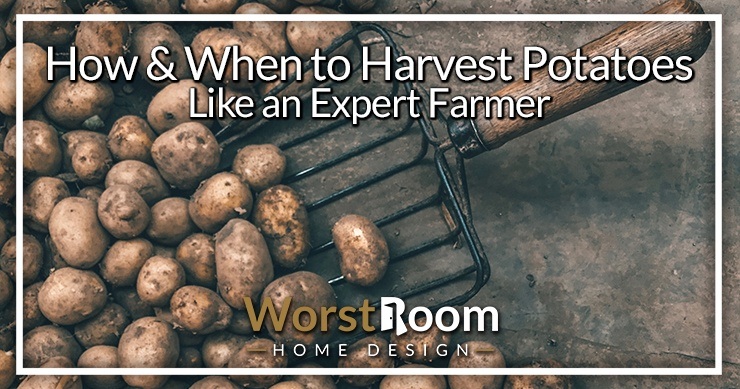
Before you start digging, you need to know exactly when to harvest potatoes. There's a too soon, a too late, and the proper methodology.
If you're like many of us would-be farmers, grocery store potatoes have you feeling uninspired. You've just discovered exactly why home gardeners love to grow their own potatoes.
There’s a certain extra deliciousness you’ll enjoy when you can grab a fresh potato from the garden in the afternoon and serve it for dinner that same evening. Let's make that happen, from garden straight to the dinner table.
How & When to Harvest Potatoes: The Basics
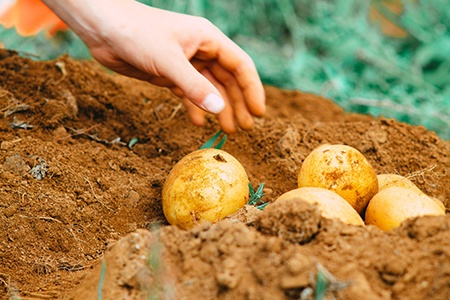
Despite the fact that they’re underground, your potatoes are still able to tell you when they're ripe and ready, and that’s the most important thing to know about how to harvest potatoes.
This is very useful because the correct time to plant and harvest a potatoe can vary depending on where you live, just like the best time to plant fruit trees. Taters are often harvested in the fall or winter, but that still leaves a lot of room for guessing incorrectly and harvesting too early or too late, if you don’t know this one neat trick…
The key to answering when you should harvest potatoes is simply to look at the leaves that are above ground, on the top of your potato plants. After your potatoes have finished growing, the top of the plant will die off gradually.
You’ll know it’s time when the flowers stop blooming, and the plant starts to get droopy and sad looking. Some of the leaves will start to drop and change color, too. This means it’s time to start digging, and time to start enjoying the fruits of your labor (or the vegetables of your labour, as the case may be.)
Tools for Harvesting Potatoes
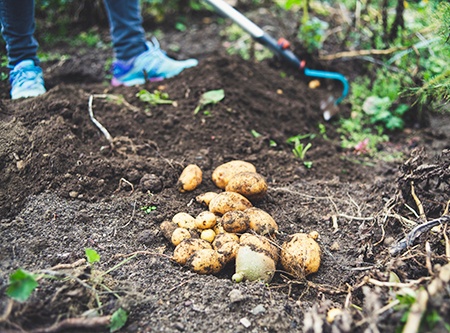
Having the best tool for the job makes life a lot easier, especially when it comes to something like a potato harvest. It’s a lot of hard work when you have a decent sized crop, or even a smaller backyard garden.
Garden gloves: If you just have a smaller potato plant, you can go digging with nothing but your hands and some garden gloves. This gives you the best chance of feeling the potatoes and not damaging any of them, but it’s also more time-consuming if you have more than a smallish plant or two.
Garden trowel: A trowel is the next step up, you can use it along with your hands (again, for smaller harvests, like if you’re digging up new potatoes for instance.) It’ll give you a little more control over the displacement of the earth, and will make it easier to dig than just using your hands.
Spade / Fork: For larger plants and harvests, you’ll want to dig up your potatoes with a spade or a garden fork. You could probably use any of the types of forks, really. Go in carefully, since these tools give you less tactile control and can damage your potatoes.
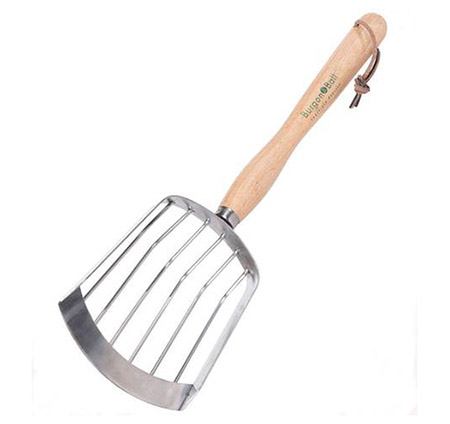
Potato scoop: This is a specialized tool that acts as a shovel and kind of like a colander for potatoes. It allows you to dig into the ground and scoop up potatoes, and has enough space for the dirt to fall through.
It’s similar to using a pitchfork in the sense that it makes it easy to shake the dirt off, but it’s designed to hold your tubers in place. Imagine catching a fish with a net and how the water falls away but the fish stays in the net. It’s exactly like that. Make sure to maintain your tools with our guide on how to remove rust from tools!
Other Things to Keep In Mind
Depending on your climate, soil, and how well you care for your plants, it usually takes about 3-4 months for a potato plant to be ready for harvest. Don’t rely 100% on this guideline, because a lot of variables can change things around, but it’s still good to have a rough idea.
If any of your potatoes are green upon harvest, discard them. Don’t compost them, just get rid of them. This could mean they’ve been hit with toxins, and you don’t want that sort of thing sticking around. They won’t be enjoyable to eat, and it’s better to count your losses instead of risking the future problem of spreading the poison.
What About When to Harvest New Potatoes?
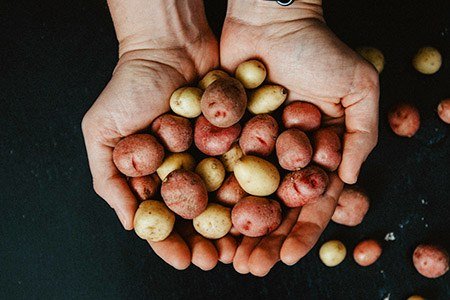
“New” potatoes aren’t some special new type of plant. These are simply less-mature potatoes. If you dig them up slightly sooner than normal, you’ll have a delicious little treat.
They’re also known as baby potatoes, and they’re great for cutting into halves or quarters and frying up with some butter or using in a pot roast. The texture and the flavor are notable, and this is a perfect compromise for anyone who is really excited to start digging into their potatoes and doesn’t want to wait until the very end of the season.
The downside to harvesting new potatoes is that you’ll end up with an overall lower yield of potato, since you’re harvesting them before they’ve finished growing. The good news is that it doesn’t have to be one or the other; you can harvest some of them early and let the rest of your spuds continue growing.
To harvest new potatoes, just watch for the leaves to start turning yellow as you approach the end of the season, but don’t wait for them to completely die off.
If you need an excuse to do some digging, harvesting a few new potatoes will give you a glimpse into how things are progressing, and could give you an opportunity to address any issues like bugs or a lack of fertilizer, too.
Harvesting Potatoes Too Early or Too Late? Here’s What Will Happen
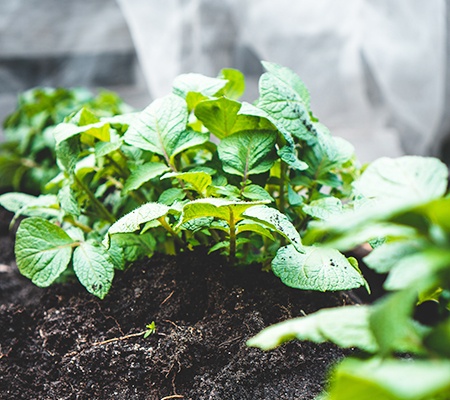
Harvesting potatoes on the earlier side, as we just went over, will give you small baby potatoes that are delicious are great for eating, but with a lower yield since they haven’t had as much time to grow.
However, if you harvest even earlier than that, you won’t get anything! The potatoes won’t have had time to grow, so be mindful of the foliage on your potato plants. If the leaves are still looking perfectly lush and healthy, it’s too soon to harvest, even if you want new potatoes.
Harvesting your potatoes too late, on the other hand, means they’ll likely become damaged by frost. If your area is going to get hit with frost before your potatoes are completely mature, you’re better off snatching them out of the ground and having new potatoes because after frost hits, that’s trouble.
It’s not necessarily a death sentence since the potatoes are snugly underground, but if the leaves above ground get hit with frost, they’ll turn dark and wither and die, and they’ll no longer be able to provide sunlight and nourishment to the roots and the spuds themselves.
What About Growing Potatoes Vertically?
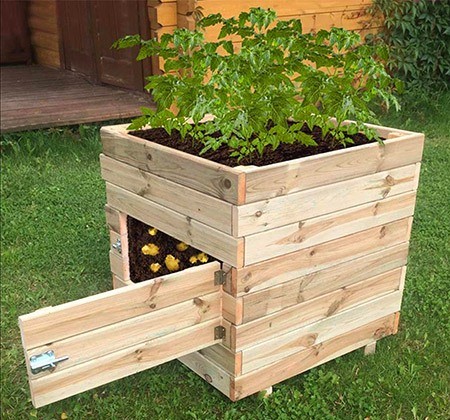
Potato towers allow you to plant them vertically in a very unique way that can give you an incredible yield.
Basically, you plant your potatoes in the ground as normal, and as the plant grows taller, you build a box around it and add more and more dirt, until you eventually have a tower that can be several feet tall.
Then when it’s time to harvest, you simply pull away one side of this tower (usually built out of wood) and let all of the dirt inside collapse until you’re left with a huge pile of soil and potatoes to dig through.
When growing potatoes vertically, the rules about when to harvest are the same, except you definitely want to check a few of them first, even if you have to climb up on a ladder to get to the top of your tower. The last thing you want to do is prematurely open up the tower, only to find out that your potatoes aren’t ready yet.
When Do You Harvest Potatoes?

I wanted to see what some of the other experts and regular gardeners out there like to do, and to see what other tips and tricks we could come up with. When are potatoes ready to harvest?
Wait until the tops of the foliage are entirely dried up, they’ll crackle if you squeeze them in between your fingers, and break easily. If the leaves fold and bend and aren’t dry yet, then your potatoes are not yet ready to harvest. This is the best way to tell when potatoes are ready for harvest.
The perfect time for fully mature potatoes is usually 15 or 20 days after the tops of the plant have dried. If you’re expecting the ground to freeze before that happens, you can harvest earlier for less-mature potatoes that will still be great. Now you know exactly when to harvest potatoes, in other words when to dig potatoes for optimal yields.



